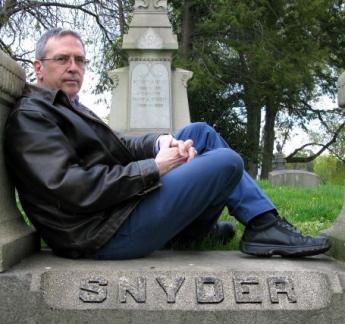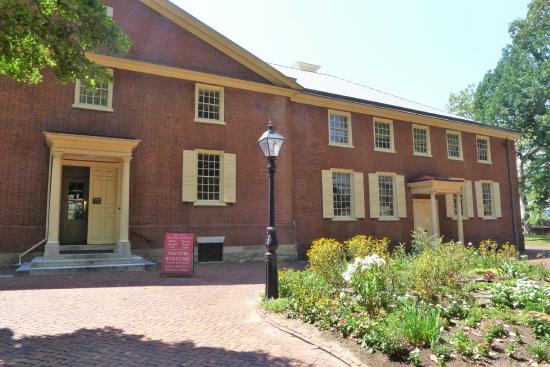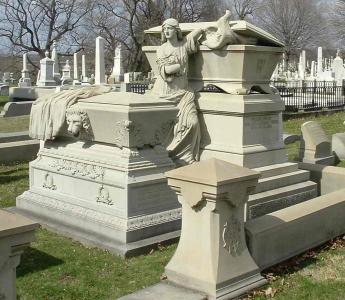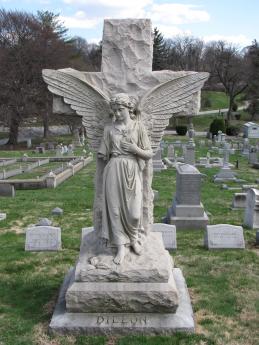Related Topics
Personal Reminiscences
One of the features of aging past ninety is accumulating many stories to tell. Perhaps fewer are left alive to challenge insignificant details.
Right Angle Club 2017
Dick Palmer and Bill Dorsey died this year. We will miss them.
Ethnic Cemeteries

|
| Ed Snyder |
Schneider spelled Snyder (or Snider) is almost certainly a Pennsylvania Dutch surname in some sense. I presume Ed Snyder is of that derivation, but at any rate, he addressed the Right Angle Club recently on the subject of photographing cemeteries. Along the way, he seems to have picked up a lot of historical facts about graveyards, which he put together into a fascinating story. I get the impression many of the traditions he described originated in Europe and were transported here by various waves of immigration. So we don't have much information about the origins of those customs, except by inference.

|
| Meeting House on 4th |
The Quakers who settled Philadelphia in the early 1680s didn't believe in putting your name (or your picture) on anything, feeling that would be idolatry. The tradition, plus the yellow fever epidemics, accounts for the Meeting House at Fourth and Arch having forty thousand people buried in its yard, in five layers, but above them only two tombstones. Just why those two were exceptions is not described. Jonathan E. Rhoads, the famous University of Penn surgeon, has his name on a pavilion at the hospital to which he raised a loud objection, but he finally died there himself, saying, "It didn't look so bad." So we have comparatively few early Quaker monuments still standing in the Quaker City, although it does seem pretty certain the Quakers are not responsible for the midnight vandalism now sweeping the country, toppling tombstones. In any event, there definitely is an anti-cemetery movement going around our nation, possibly dating back to the days when bodies of parishioners were buried in churchyards if they were in good standing, sort of a giant compost heap. On the other hand, some people remember that Antigone went to some lengths to recover and honor her dead brother on the battlefield of ancient Greece. And that one of the reasons the Romans fed the early Christians to the lions was their horror at the retention of the bones of ancestors in the catacombs. Christians actually took residence in the mortuaries in the expectation of a second coming for everybody. The Mormon infatuation with genetic ancestors may be part of this concept.

|
| Laurel Hill Cemeteries |
It has been said that if you stick a shovel in the ground anywhere, you will encounter a cemetery, but not in Philadelphia. Somewhere around 1830, we imported the French set of traditions of cemeteries, which you can still see as the questionable tombstones of Abelard and Heloise outside Paris. Laurel Hill in Philadelphia was started as an intentional commercial imitation, at a time when you had to take a boat on the Schuylkill to get there, taking the whole family along to have an all-day picnic among your ancestors; and mighty industrial potentate families competed to construct the biggest most expensive mausoleum for the family. Laurel Hill has since fallen into some disrepair, but there is a restoration movement actively repairing it, collecting donations, tracing histories, etc. Neill Bringhurst, a former president of the Right Angle Club, was once the owner, but he vigorously disliked the whole idea and sold it. Woodland, near the University of Pennsylvania, is the other surviving cemetery of this elegance, and it is kept up much better than Laurel Hill, except for the tangled bushes around the periphery to maintain privacy. Woodland is right next to an extensive trolley-car terminal, thus conveying some idea of its former popularity. Prior to being a cemetery, it was the mansion site of Andrew Hamilton, whom George Washington used to visit on his way to Mount Vernon. As you recall, this Hamilton was the original Philadelphia Lawyer, who went to New York to defend the freedom of speech of Peter Zenger the newspaper man accused of telling the truth when he slandered the Governor. Considering the successor governors of New York, it's a good thing he won the case. History has it he was a young unrecognized lawyer, but in fact, Hamilton was the most eminent lawyer of his time, having originally purchased what is now Independence Hall.

|
| Marble Angels |
The traditions of marble angels hovering over tombstones seem to have been imported by Irish and Italian immigrants and are reflected in their present cemeteries. And the Pennsylvania Dutch tombstones and records are intact in Hummelstown PA, dating back to the Seventeenth century. It reflects that this particular branch landed in New York, went up to the Hudson to Kingston, and back down to the Harrisburg area on the Susquehanna. Meanwhile, the Quakers further East were burying their dead in layers without "markers".
There's probably a lot more to this history, but burials are sort of private affairs, so most church groups are unaware of dissenting attitudes, not very far away from them.
Originally published: Wednesday, March 15, 2017; most-recently modified: Thursday, May 16, 2019